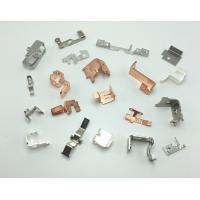High Production Efficiency and Low Material Consumption Aluminum
Stamping Parts
Stamping is a forming method that uses a press and a die to apply
external force to plates, strips, pipes and profiles to cause
plastic deformation or separation, thereby obtaining a workpiece
(stamping part) of the desired shape and size.
Stamping is a process that separates or forms sheet metal to obtain
a product. Stamping is a metal processing method that is based on
the plastic deformation of metal. It uses dies and stamping
equipment to apply pressure to sheet metal to cause plastic
deformation or separation, thereby obtaining parts (stamping parts)
with a certain shape, size and performance.
The stamping process can be divided into four basic processes:
Punching: a stamping process that separates sheet metal (including
punching, blanking, trimming, cutting, etc.).
Bending: a stamping process that bends sheet metal into a certain
angle and shape along the bending line.
Drawing: a stamping process that turns flat sheet metal into
various open hollow parts, or further changes the shape and size of
hollow parts.
Local forming: A stamping process that uses various local
deformations of different properties to change the shape of a blank
or stamping part (including flanging, bulging, leveling and shaping
processes, etc.).
Process characteristics
(1) Stamping is a processing method with high production efficiency
and low material consumption.
(2) The operation process is convenient and does not require the
operator to have a high level of skills.
(3) Stamped parts generally do not need to be machined again and
have high dimensional accuracy.
(4) Stamping parts have good interchangeability. The stamping
process has good stability, and the same batch of stamping parts
can be used interchangeably without affecting assembly and product
performance.
(5) Since stamping parts are made of sheet metal, their surface
quality is good, which provides convenient conditions for
subsequent surface treatment processes (such as electroplating and
painting).
(6) Stamping can obtain parts with high strength, high rigidity and
light weight.
(7) Stamping parts mass-produced by molds are low-cost.
(8) Stamping can produce parts with complex shapes that are
difficult to process by other metal processing methods.
Advantages of stamping processing
1. Stamping processing has high production efficiency, convenient
operation, and easy mechanization and automation.
2. Stamping has stable quality, good interchangeability, and has
the characteristics of "exactly the same".
3. Stamping has high strength and rigidity.
4. The cost of stamping parts is low.







